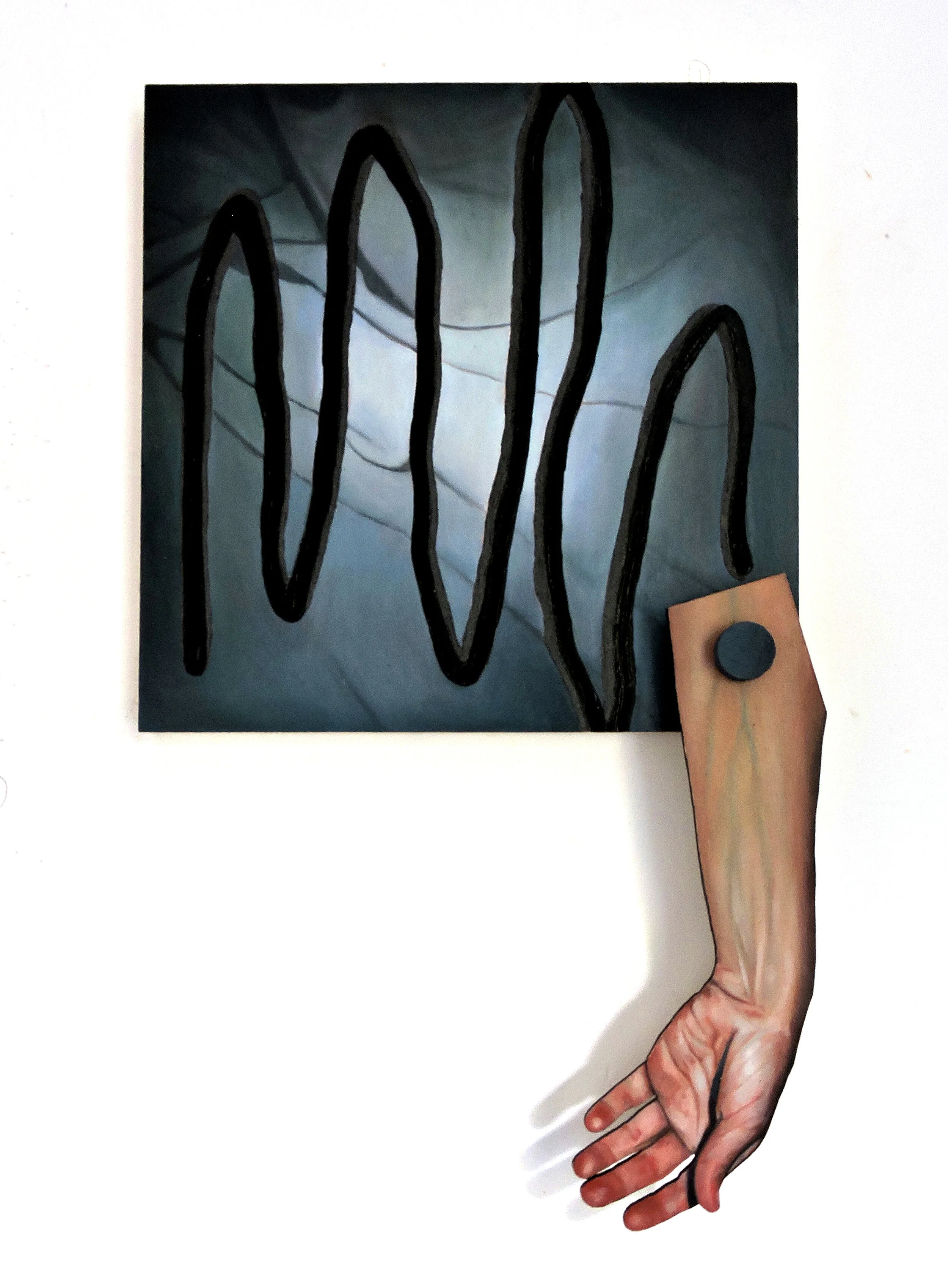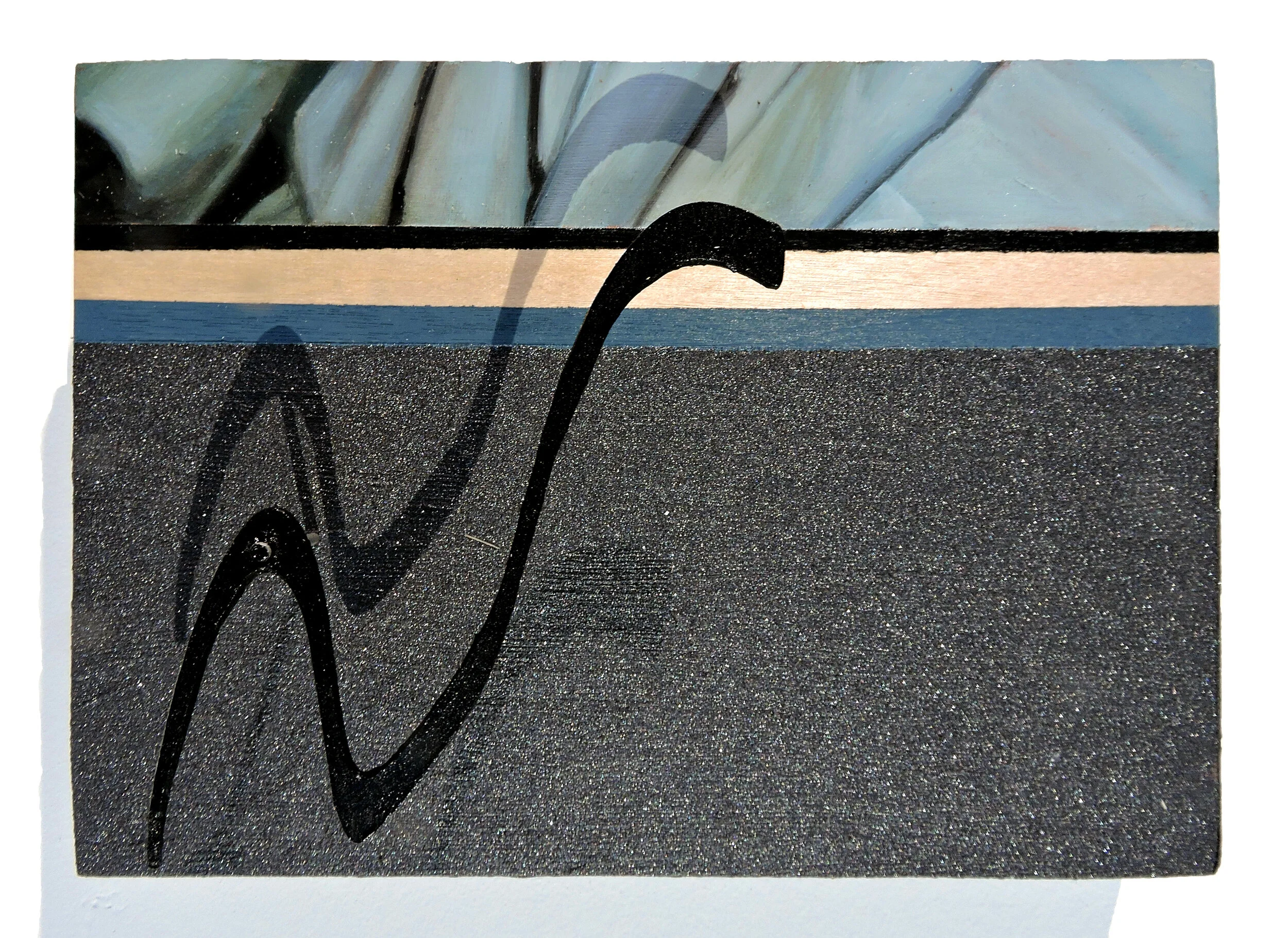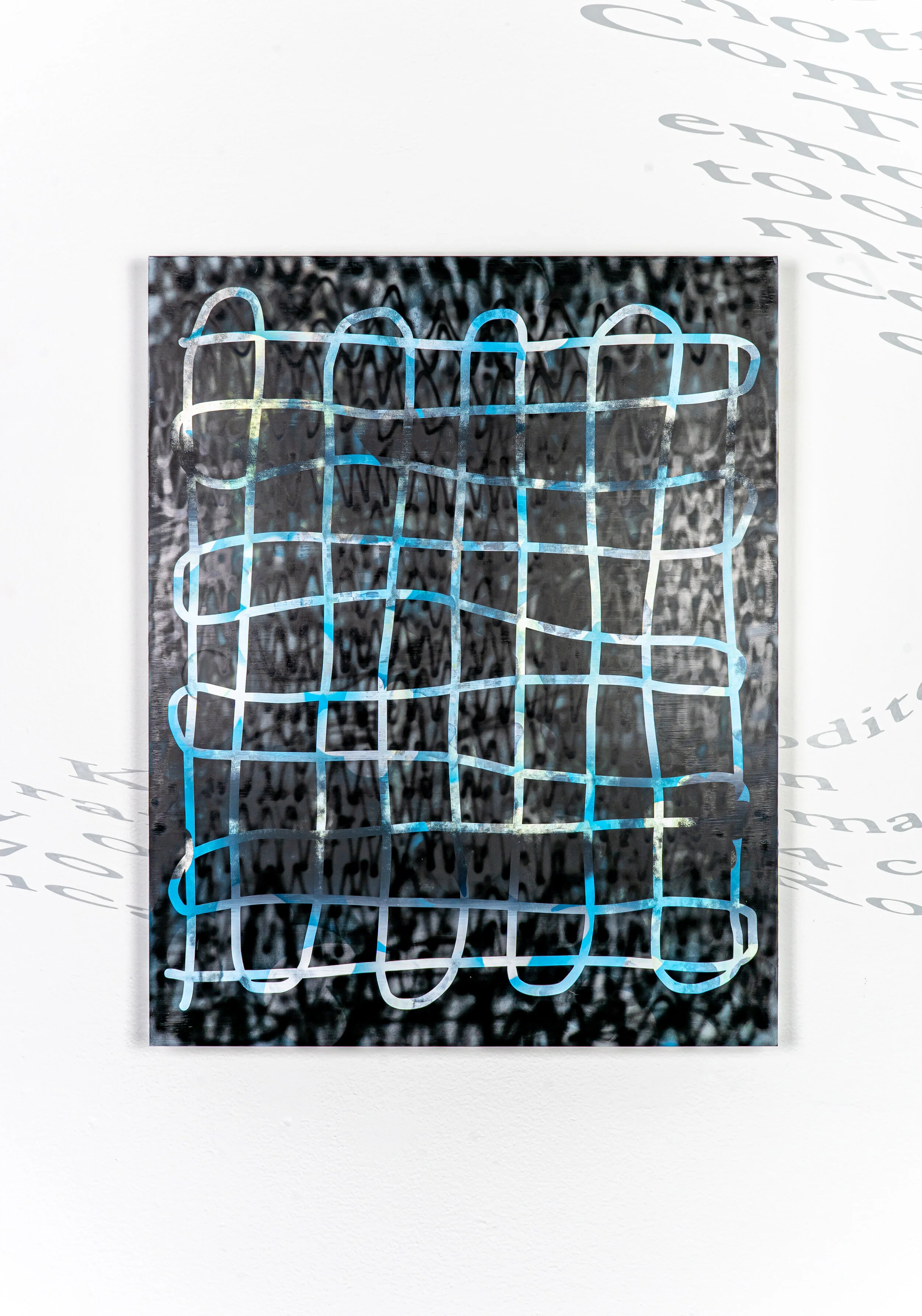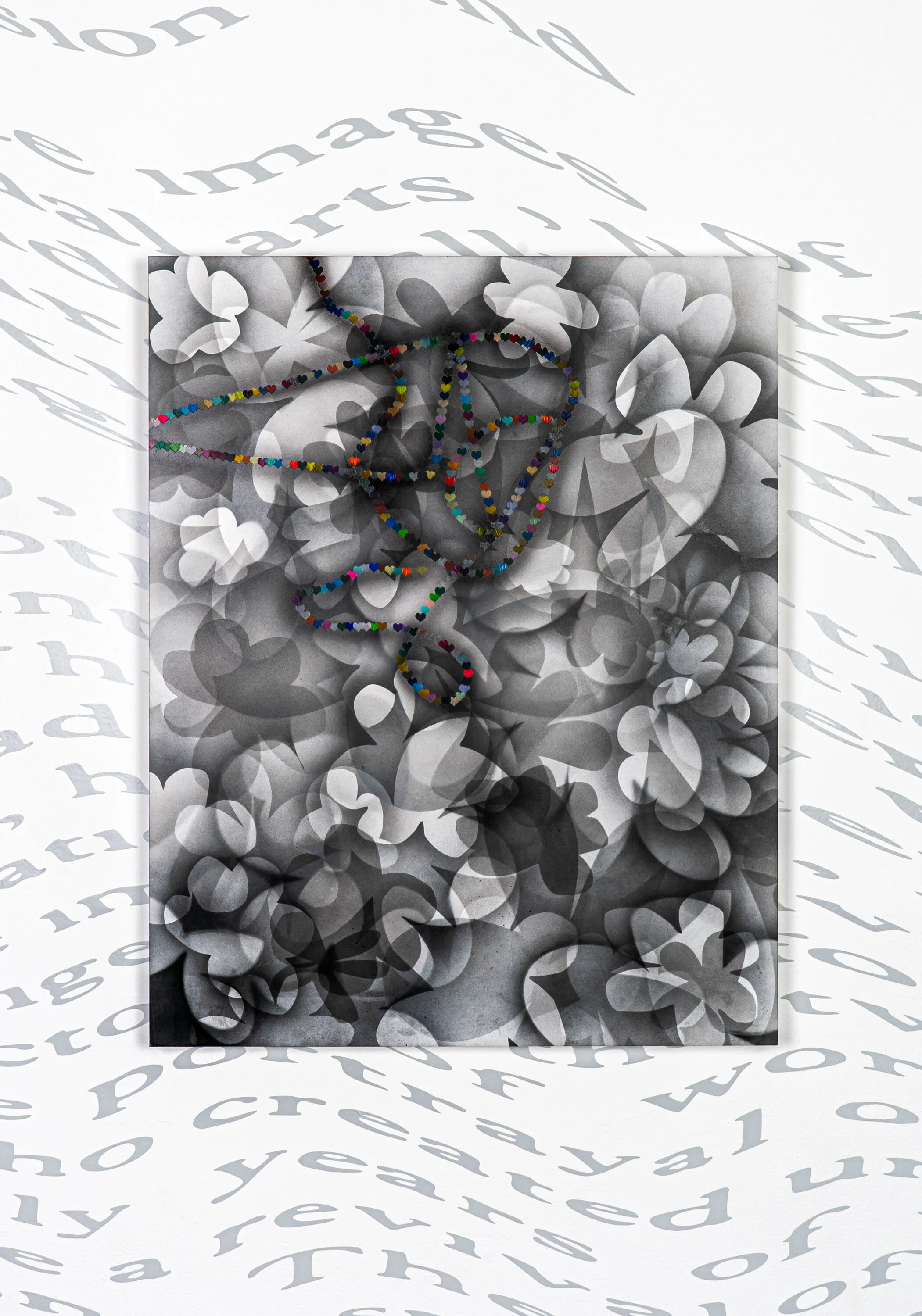A Closer Look: Repeater by Amber Tutwiler
We invite you to experience this body of work through a new lens as each painting becomes a line of prose with subtle gestures rhythmically echoing each other back and fourth.
Each exhibition, we approach our ‘Gallery Insider’ newsletter as an opportunity to take a closer look at a few of the works on view. However, with our current exhibition, Repeater, a solo show of paintings by Amber Tutwiler, we’ve taken a different approach and chosen to highlight the exhibition’s more silent partner - a piece of writing. Tutwiler shares, “Just as the folds of fabric rhythmically dance through each frame, the titles of each work, when read from left to right, act as poetic substrates to the body of work as a whole”.
In our artist talk with Tutwiler last month, she discussed the importance of writing within her artistic practice. If you missed the talk, you can still view it here. Tutwiler notes that the folds of fabric presented in the series are often the same exact folds repeated throughout, visually referencing the psychological phenomenon, Semantic Satiation, in which repetition causes a word or phrase to temporarily lose meaning for the listener, who then perceives the speech as repeated meaningless sounds. In this way, language and imagery bear equal weight within Repeater.
We invite you to experience this body of work through a new lens as each painting becomes a line of prose with subtle gestures rhythmically echoing each other back and fourth.
They say (go ahead),
Follow, repeater.
This belly traces time
In slow motion.
Cue the curtain,
Return the island,
With it closed,
We see the other side of the desert.
Planes and glass,
A performance, a mirage.
So many gaps,
No shadow can doubt, We must be
Too close.
The inevitability of the ghost,
Of us, etc.
Sleep myself a love to calm.
Repeater has been extended to November 12th and our gallery is now available for viewings, Thursday evenings 5-7pm. Please email sammi@isprojectsfl.com to make an appointment.
Interested in purchasing work?
Visit our Gallery Shop
A Closer Look: Copy of the Original by Rachel Livedalen
It is our pleasure to present Rachel Livedalen’s solo exhibition, Copy of the Original, a series of works on panel that combine screen printed layers of Greco-Roman textbook pages (Page 56 Parts I - IV) with airbrush and gouache. Structured information depicted in these works relate to the construction and continuation of the art history canon and the way in which we understand visual culture.
It is our pleasure to present Rachel Livedalen’s solo exhibition, Copy of the Original, a series of works on panel that combine screen printed layers of Greco-Roman textbook pages (Page 56 Parts I - IV) with airbrush and gouache. Structured information depicted in these works relate to the construction and continuation of the art history canon and the way in which we understand visual culture. Textual information appropriated from the same art history text book page surfaces throughout the works and installation. The text is stretched, morphed, or veiled, then layered with different modes of visual information like coded symbols, colorful shapes, or erased gestures. The goal of the work is to question our understanding of visual information both from academic art history and popular culture as it relates to beauty, feminine representation, and artifice. Specifically, these paintings analyze the Knidian Aphrodite, the first sculpture of a female nude in Greek art that now only exists as a Roman copy. This canonical work from western art history thus embodies ideas of representation and reproduction throughout history.
Livedalen’s approach to painting is unmistakably informed by printmaking and often blurs the line between the two disciplines. In the piece, Page 56 Part III, paint is applied to the surface of her panel through careful layering. Livedalen expounds, “Page 56 Part III features a cropped view of the original art history book page, but all the text is masked by layers of black airbrush paint. Superimposed on top are colorful gouache shapes, further obscuring the information presented in the screen printed text layer of the painting.”
Page 56 Part I features a more gestural and loose black airbrushed mark, obscuring screen printed text and further pushing its illegibility. While the text is seemingly inaccessible, Livedalen leaves a thread of clues for the viewer. “In this work, colorful shapes are painted on top of each letter of the text and are coded so that each letter is given a specific color and shape.” This code of colorful shapes is carefully painted through a stencil, mimicking screen printing
The exhibition progresses to two more paintings, Revisions and To Dovetail, which continue to explore the layering and concealment of Livedalen’s symbols and text. Livedalen adds, “[these works] build off of the visual language explored in Page 56 Parts I-IV. […] They both use stenciling techniques to control the boundaries of these layers, exploring restraint of both material and visual reference.”
A large mural of gray text dominates the exhibition space and provides a familiar backdrop for Livedalen’s paintings. “This text excerpt again borrows from [the same text] as the paintings. This page records the beginning of a paragraph titled ‘The Female Nude A New Theme in Greek Art’.” The text is morphed as it waves across two adjoined walls in the gallery space and is adhered to the wall in a pale gray adhesive vinyl.
“The text is meant to transform the exhibition space beyond the neutral white gallery cube. It calls back to the reference explored in the paintings and provides a physical and symbolic background for the artworks.
The image of the Knidian Aphrodite is also represented in wall vinyl, but unceremoniously turned on her side and tucked under the gallery window.”
Copy of the Original will be on view through the end of August. The gallery lights will be left on 24 hours so that our local audience can safely access the exhibition through our large storefront windows while we remain closed to the public. We also invite you to view the works more closely through our Virtual Gallery Tour.
For pricing and additional information on the works in the show, please visit our Gallery Shop and feel free to reach out to me via email with any inquiries at sammi@isprojectsfl.com
Sincerely,
Sammi McLean
Gallery Coordinator
Printmaking & Book Arts Studio
17 NW 5th St Fort Lauderdale, FL 33301
www.isprojectsfl.com
A Closer Look: The Mechanical Bride
As a gallery attached to a printmaking and book arts studio, we aim to feature artists with an expert sense of craft and process, regardless of the medium. This exhibition is no exception, featuring predominantly smaller-scale weaving and embroidery works by Baskin and Humphreys. With their concise and muted color palettes, each work is deceptively simple at a distance, only revealing their expansive intricacies and landscapes of thread through close and careful examination. So, let’s take a closer look, shall we?
Just weeks before the official opening reception of Sasha Baskin and Christina Humphrey’s two-person exhibition, The Mechanical Bride, the IS Projects gallery had to sadly close its doors to the public due to COVID-19. Given that you are a friend of the gallery and/or the exhibiting artist, I am reaching out to share an exclusive closer look at some of the pieces in the show in an effort to further the reach of this exceptional work.
As a gallery attached to a printmaking and book arts studio, we aim to feature artists with an expert sense of craft and process, regardless of the medium. This exhibition is no exception, featuring predominantly smaller-scale weaving and embroidery works by Baskin and Humphreys. With their concise and muted color palettes, each work is deceptively simple at a distance, only revealing their expansive intricacies and landscapes of thread through close and careful examination. So, let’s take a closer look, shall we?
Perhaps the ‘centerpiece’ of the exhibition is Sasha Baskin’s weaving, ‘Study for Jenny’s Departure’. By far the largest piece in the show, this work measures 40” x 30” and is comprised of digital and hand woven cotton and silk with rosette overshot patterning and natural dye. The woman depicted, along with many of Baskin’s motifs, are sourced from the reality television series, The Bachelor. According to Baskin, this work is part of a larger series addressing modern mythology through the lens of popular culture.
Dramatic (Study for Jenny’s Departure), 2018
Digital and hand woven cotton and silk,
rosette overshot patterning, natural dye
Screenshot from The Bachelor (Season 22)
40” x 30”
Study for jenny’s departure, detail
“This image depicts a woman rejected by the lead during the second episode of the season. I was struck by her strength and resiliency in the face of reality television rejection and explored her character as a modern mythological figure. Throughout this series, I repeat a rose and woven rosette motif. This work glitches and distorts a modified rosette pattern structure (a traditional overshot weaving pattern typically used in American Coverlets). A rose is the symbol of validation on ‘The Bachelor’ and receiving a rose allows a contestant to continue on to the next week. Through the repetition and distortion of this rose-based weaving pattern, I offer the woman getting rejected a form of agency and control over her own roses.”
Roses are echoed throughout the exhibition in framed, delicate lace pieces which punctuate the gallery.
Portrait of Lacy in Black and White
(After Da Vinci’s “Portrait of a Woman”), 2018
Digital and hand woven cotton and silk screenshot from
“Bachelor in Paradise” (Season 4)
14” x 11”
“Portrait of Lacy in Gold (After Da Vinci’s “Portrait of a Woman”), 2018
Digital and hand woven cotton and silk screenshot from
“Bachelor in Paradise” (Season 4)
14” x 11”
Pictured above are two partner pieces, ‘Portrait of Lacy in Black and White’ and ‘Portrait of Lacy in Gold’. “This image takes the same screenshot of a supporting character in the reality tv universe and creates an optical illusion through thread and pattern. Just as a digital image relies on perspective and the interaction of pixels and light, [Portrait of Lacy in Gold] appears and disappears based on the viewer's perspective. Due to the interaction of reflective silk and twill woven patterning, the image can become invisible and, from certain angles, the cloth appears blank.”
The Mechanical Bride takes shape through the conversation between Baskin and Humphreys’ bodies of work. The artists find common ground in examining the consumption of mass media and its manifestations in our lives. Through a series of six embroideries, Humphreys addresses her own anxieties while searching for answers on the internet and seeking truth in an abundance of conflicting information, untruths and unknowns. She conveys this by focusing on distorting recognizable symbols with heavily applied patterns in abstract compositions.
Samples, 2019
embroidery on stretched cloth, wood frame
8.5” x 8.5”
“The embroidery designs I'm working on right now are sort of disease-like - contrasting patterns overlapping each other and distorting somewhat recognizable text and symbols. They have a certain anxiousness to them that relates to how I feel reading the news online and engaging with social media.”
Over the course of eight months leading up to an exhibition, Christina Humphreys created the works on view, each of them progressively more influenced by events that were unfolding at the time. “The ‘diseased’ patterns I was making started to take on a literal meaning beyond the metaphorical, as the world began to understand and respond to the spread of Coronavirus.”
BWR2, 2020
embroidery on stretched cloth, wood frame
11”x10”
BWR2, detail
The piece, BWR2, is the largest and final piece of the series combining recognizable patterns, distorted shapes and icons, and the color red as an indicator of contamination.
Cover-up, 2019
embroidery on stretched cloth, wood frame
8.25” x 8”
“The title is a reference to the riddle ‘What’s black and white and read all over?’ and the shortening to BWR takes inspiration from the nomenclature of viruses. I can’t help but see the influence of pandemic on this series, especially in these final works.”
Humphreys’ process begins with constructing a digital image, examining her marks as pixels before stitches. Then the designs are painstakingly executed through an analog process of hand-embroidery.
“I’ve increasingly felt a strong connection to the (painfully) slow process of stitching in contrast with the speed of creating patterns digitally. In some instances, I am able to make changes to the pattern after I have already started embroidering, but that is rarely the case, and I often have to commit to a design referencing events that look completely different or are already long forgotten [by the project’s completion]. In the end, the works feel extremely personal, but I sometimes don’t even recognize them.”
As this exhibition comes to a close over the next couple weeks, we will leave the gallery lights on 24 hours so that our local audience can safely access the exhibition through our large storefront windows. We also invite you to view the works more closely through our Virtual Gallery Tour.
For pricing and additional information on the works in the show, please visit our Gallery Shop and feel free to reach out to me via email with any inquiries at sammi@isprojectsfl.com
Sincerely,
Sammi McLean
Gallery Coordinator
Printmaking & Book Arts Studio
17 NW 5th St Fort Lauderdale, FL 33301
www.isprojectsfl.com




































